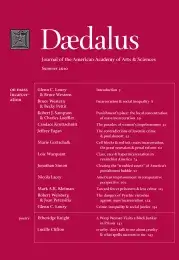Class, race & hyperincarceration in revanchist America
The single greatest political transformation of the post-civil rights era in America is the joint rolling back of the stingy social state and rolling out of the gargantuan penal state that have remade the country’s stratification, cities, and civic culture, and are recasting the very character of “blackness” itself. Together, these two concurrent and convergent thrusts have effectively redrawn the perimeter, mission, and modalities of action of public authority when it comes to managing the deprived and stigmatized populations stuck at the bottom of the class, ethnic, and urban hierarchy. The concomitant downsizing of the welfare wing and up-sizing of the criminal justice wing of the American state have not been driven by raw trends in poverty and crime, but fueled by a politics of resentment toward categories deemed undeserving and unruly. Chief among those stigmatized populations are the public-aid recipients and the street criminals framed as the two demonic figureheads of the “black underclass” that came to dominate the journalistic, scholarly, and policy debate on the plight of urban America1 in the revanchist decades that digested the civil disorders of the 1960s and the stagflation of the 1970s, and then witnessed the biggest carceral boom in world history.2
In this article, I show that the stupendous expansion and intensification of the activities of the American police, criminal courts, and prison over the past thirty years have been finely targeted, first by class, second by race, and third by place, leading not to mass incarceration but to the hyperincarceration of (sub)proletarian African American men from the imploding ghetto. This triple selectivity reveals that the building of the hyperactive and hypertrophic penal state that has made the United States world champion in incarceration is at once a delayed reaction to the civil rights movement and the ghetto riots of the mid-1960s3 and a disciplinary instrument unfurled to foster the neoliberal revolution by helping to impose insecure labor as the normal horizon of work for the unskilled fractions of the postindustrial laboring class.4 The double coupling of the prison with the dilapidated hyperghetto, on the one side, and with supervisory workfare, on the other, is not a moral dilemma–as recently argued by Glenn Loury in his Tanner Lecture5–but a political quandary calling for an expanded analysis of the nexus of class inequality, ethnic stigma, and the state in the age of social insecurity. Reversing the racialized penalization of . . .
